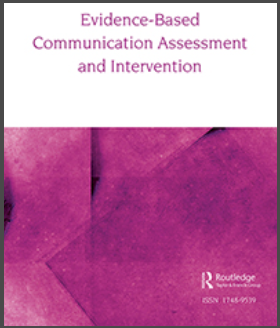David Celiberti, PhD, BCBA-D
Association for Science in Autism Treatment
 Communication is a powerful and necessary skill set, particularly for individuals with autism who may face significant challenges in expressing themselves. Fortunately, there are numerous interventions that can help with effective communication; however, not all communication methods are equally valid and scientifically supported. Some methods, such as Facilitated Communication (FC) and its many derivatives, purport to help individuals with severe communication impairments type or point to letters with the assistance of a facilitator. However, these methods are not based on scientific evidence. Further, we have witnessed significant negative consequences, some of which can be dangerous, for the individuals who use them, as well as their families.
Communication is a powerful and necessary skill set, particularly for individuals with autism who may face significant challenges in expressing themselves. Fortunately, there are numerous interventions that can help with effective communication; however, not all communication methods are equally valid and scientifically supported. Some methods, such as Facilitated Communication (FC) and its many derivatives, purport to help individuals with severe communication impairments type or point to letters with the assistance of a facilitator. However, these methods are not based on scientific evidence. Further, we have witnessed significant negative consequences, some of which can be dangerous, for the individuals who use them, as well as their families.
ASAT is proud to sponsor this special issue from Evidence-based Communication Assessment and Intervention which provides a comprehensive overview of the evidence on these techniques from different perspectives—scientific, ethical, and conceptual. Edited by Drs. Russell Lang, Ralf Schlosser, and Rajinder Koul, this special issue informs service providers, family members, and the public about the risks and dangers of these methods. This collection of articles also highlights the importance of promoting evidence-based practices that respect the dignity and autonomy of individuals with communication impairments, as well as their right to interventions that bolster their communication skills based on the very best that science has to offer.
The articles included in this special issue include:
Boynton, J. (2012). Facilitated communication – what harm it can do: Confessions of a former facilitator. Evidence-based Communication Assessment and Intervention, 6(1), 3-13.
https://doi.org/10.1080/17489539.2012.674680
Beals, K. (2021). A recent eye-tracking study fails to reveal agency in assisted autistic communication. Evidence-based Communication Assessment and Intervention, 15(1), 46-51.
https://doi.org/10.1080/17489539.2021.1918890
Beals, K. (2022). Why we should not presume competence and reframe facilitated communication: a critique of Heyworth, Chan, & Lawson. Evidence-based Communication Assessment and Intervention, 16(2), 66-76.
https://doi.org/10.1080/17489539.2022.2097872
Chan, J., & Nankervis, K. (2015). Stolen voices: Facilitated communication is an abuse of human rights. Evidence-based Communication Assessment and Intervention, 6(1), 151-156.
https://doi.org/10.1080/17489539.2014.1001549
Hemsley, B. (2016). Evidence does not support the use of Rapid Prompting Method (RPM) as an intervention for students with autism spectrum disorder and further primary research is not justified. Evidenced-based Communication Assessment and Intervention, 10(4), 122-130.
https://doi.org/10.1080/17489539.2016.1265639
Hemsley, B. & Dann, S. (2015). Social media and social marketing in relation to facilitated communication: harnessing the affordances of social media for knowledge translation. Evidence based Communication Assessment and Intervention, 8(4), 187-206.
https://doi.org/10.1080/17489539.2015.1023988
Lang, R., Tostanoski, A. H., Travers, J., & Todd, J. (2014). The only study investigating the rapid prompting method has serious methodological flaws but data suggest the most likely outcome is prompt dependency. Evidence-based Communication Assessment and Intervention, 8(1), 40-48.
https://doi.org/10.1080/17489539.2014.955260
Lilienfeld, S. O., Marshall, J., Todd, J. T., & Shane, H. C. (2015). The persistence of fad interventions in the face of negative scientific evidence: Facilitated communication for autism as a case example. Evidence-based Communication Assessment and Intervention, 8(2), 62-101.
https://doi.org/10.1080/17489539.2014.976332
Mirenda, P. (2015). Comments and personal reflection on the persistence of facilitated communication. Evidence-based Communication Assessment and Intervention, 8(2), 102-110.
https://doi.org/10.1080/17489539.2014.997427
Mostert, M. P. (2012). Facilitated communication: The empirical imperative to prevent further professional malpractice. Evidence-based Communication Assessment and Intervention, 6(1), 18-27.
https://doi.org/10.1080/17489539.2012.693840
Mostert, M. P. (2015). A revised imperative for curbing the lie of facilitated communication. Evidence-based Communication Assessment and Intervention, 9(2), 82-90.
https://doi.org/10.1080/17489539.2015.1066560
Palfreman, J. (2012). The dark legacy of FC. Evidence-Based Communication Assessment and Intervention, 6(1), 14-17.
https://doi.org/10.1080/17489539.2012.688343
Schlosser, R., & Wendt, O. (2008). Facilitated communication is contraindicated as a treatment choice: A meta-analysis is still to be done. Evidence-based Communication Assessment and Intervention, 2(2), 81-83.
https://doi.org/10.1080/17489530802295121
Tetzchner, S. V. (2012). Understanding facilitated communication: Lessons from a former facilitator—Comments on Boynton, 2012. Evidenced-based Communication Assessment and Intervention, 6(1), 28-35.
https://doi.org/10.1080/17489539.2012.699729
Todd, J. (2012). The moral obligation to be empirical: Comments on Boynton’s “Facilitated Communication- what harm can it do: Confessions of a former facilitator. Evidenced-based Communication Assessment and Intervention, 6(1), 36-57.
https://doi.org/10.1080/17489539.2012.704738
Trembath, D., Paynter, J., Keen, D., & Ecker, U. K. H. (2016). Attention: Myth follows! Facilitated communication, parent and professional attitudes towards evidence-based practice, and the power of misinformation. Evidence-based Communication Assessment and Intervention, 9(3), 113-126.
https://doi.org/10.1080/17489539.2015.1103433
Wombles, K. (2015). Some fads never die – they only hide behind other names: Facilitated communication is not and never will be augmentative and alternative communication. Evidence-based Communication Assessment and Intervention, 8(4), 181-186.
https://doi.org/10.1080/17489539.2015.1012780

